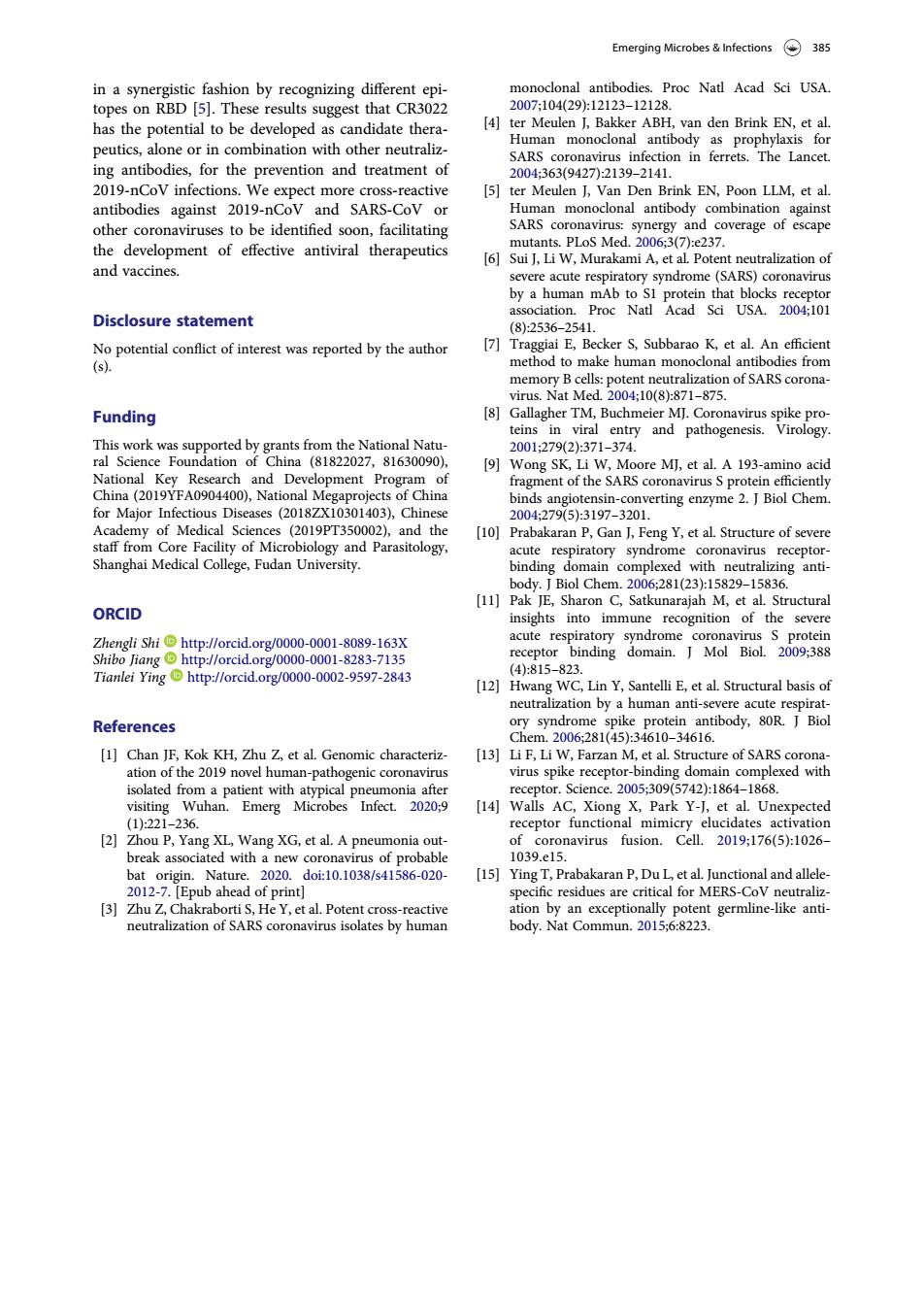正在加载图片...

Emerging Microbes& in a synergistic fashion by recognizing different epi- monoclonal antibodies Proc Natl Acad Sci USA. topes on RBD [5].These results suggest that CR3022 has the potential to be developed a an monoclonal ne or for the prevent on and treatment o 21 [5 Brink EN Poon LM et al antibodies against 2019-nCov and SARS-Cov or monodlonal antibody combination other coronaviruses to be identified soon,facilitating the development of effective antiviral therapeutics and vaccines. cami A,et al Po Disclosure statement oe ofpnd by e 82536-254 ao of SARScoron Funding 00) 200127 2371-347 ment Pre for Major Infecti ous Dise ases (2018ZX10301403),Chines [10]Prabakara P.Gan Feng Y,ct al Structure of severe Shanghai Medical Collg.Fudan University alizing anti. ORCID (12]Hwar eutr human ant References 062 34616 13E,i Of SARS receptor nding doma X.Park Y-.et al.Une ng XL Wang XG.et al.A Pr eceptor functiona break associated with a new c 039.e1 15 onal and allele rintl cific residues are cr ical for mers-c in a synergistic fashion by recognizing different epitopes on RBD [5]. These results suggest that CR3022 has the potential to be developed as candidate therapeutics, alone or in combination with other neutralizing antibodies, for the prevention and treatment of 2019-nCoV infections. We expect more cross-reactive antibodies against 2019-nCoV and SARS-CoV or other coronaviruses to be identified soon, facilitating the development of effective antiviral therapeutics and vaccines. Disclosure statement No potential conflict of interest was reported by the author (s). Funding This work was supported by grants from the National Natural Science Foundation of China (81822027, 81630090), National Key Research and Development Program of China (2019YFA0904400), National Megaprojects of China for Major Infectious Diseases (2018ZX10301403), Chinese Academy of Medical Sciences (2019PT350002), and the staff from Core Facility of Microbiology and Parasitology, Shanghai Medical College, Fudan University. ORCID Zhengli Shi http://orcid.org/0000-0001-8089-163X Shibo Jiang http://orcid.org/0000-0001-8283-7135 Tianlei Ying http://orcid.org/0000-0002-9597-2843 References [1] Chan JF, Kok KH, Zhu Z, et al. Genomic characterization of the 2019 novel human-pathogenic coronavirus isolated from a patient with atypical pneumonia after visiting Wuhan. Emerg Microbes Infect. 2020;9 (1):221–236. [2] Zhou P, Yang XL, Wang XG, et al. A pneumonia outbreak associated with a new coronavirus of probable bat origin. Nature. 2020. doi:10.1038/s41586-020- 2012-7. [Epub ahead of print] [3] Zhu Z, Chakraborti S, He Y, et al. Potent cross-reactive neutralization of SARS coronavirus isolates by human monoclonal antibodies. Proc Natl Acad Sci USA. 2007;104(29):12123–12128. [4] ter Meulen J, Bakker ABH, van den Brink EN, et al. Human monoclonal antibody as prophylaxis for SARS coronavirus infection in ferrets. The Lancet. 2004;363(9427):2139–2141. [5] ter Meulen J, Van Den Brink EN, Poon LLM, et al. Human monoclonal antibody combination against SARS coronavirus: synergy and coverage of escape mutants. PLoS Med. 2006;3(7):e237. [6] Sui J, Li W, Murakami A, et al. Potent neutralization of severe acute respiratory syndrome (SARS) coronavirus by a human mAb to S1 protein that blocks receptor association. Proc Natl Acad Sci USA. 2004;101 (8):2536–2541. [7] Traggiai E, Becker S, Subbarao K, et al. An efficient method to make human monoclonal antibodies from memory B cells: potent neutralization of SARS coronavirus. Nat Med. 2004;10(8):871–875. [8] Gallagher TM, Buchmeier MJ. Coronavirus spike proteins in viral entry and pathogenesis. Virology. 2001;279(2):371–374. [9] Wong SK, Li W, Moore MJ, et al. A 193-amino acid fragment of the SARS coronavirus S protein efficiently binds angiotensin-converting enzyme 2. J Biol Chem. 2004;279(5):3197–3201. [10] Prabakaran P, Gan J, Feng Y, et al. Structure of severe acute respiratory syndrome coronavirus receptorbinding domain complexed with neutralizing antibody. J Biol Chem. 2006;281(23):15829–15836. [11] Pak JE, Sharon C, Satkunarajah M, et al. Structural insights into immune recognition of the severe acute respiratory syndrome coronavirus S protein receptor binding domain. J Mol Biol. 2009;388 (4):815–823. [12] Hwang WC, Lin Y, Santelli E, et al. Structural basis of neutralization by a human anti-severe acute respiratory syndrome spike protein antibody, 80R. J Biol Chem. 2006;281(45):34610–34616. [13] Li F, Li W, Farzan M, et al. Structure of SARS coronavirus spike receptor-binding domain complexed with receptor. Science. 2005;309(5742):1864–1868. [14] Walls AC, Xiong X, Park Y-J, et al. Unexpected receptor functional mimicry elucidates activation of coronavirus fusion. Cell. 2019;176(5):1026– 1039.e15. [15] Ying T, Prabakaran P, Du L, et al. Junctional and allelespecific residues are critical for MERS-CoV neutralization by an exceptionally potent germline-like antibody. Nat Commun. 2015;6:8223. Emerging Microbes & Infections 385